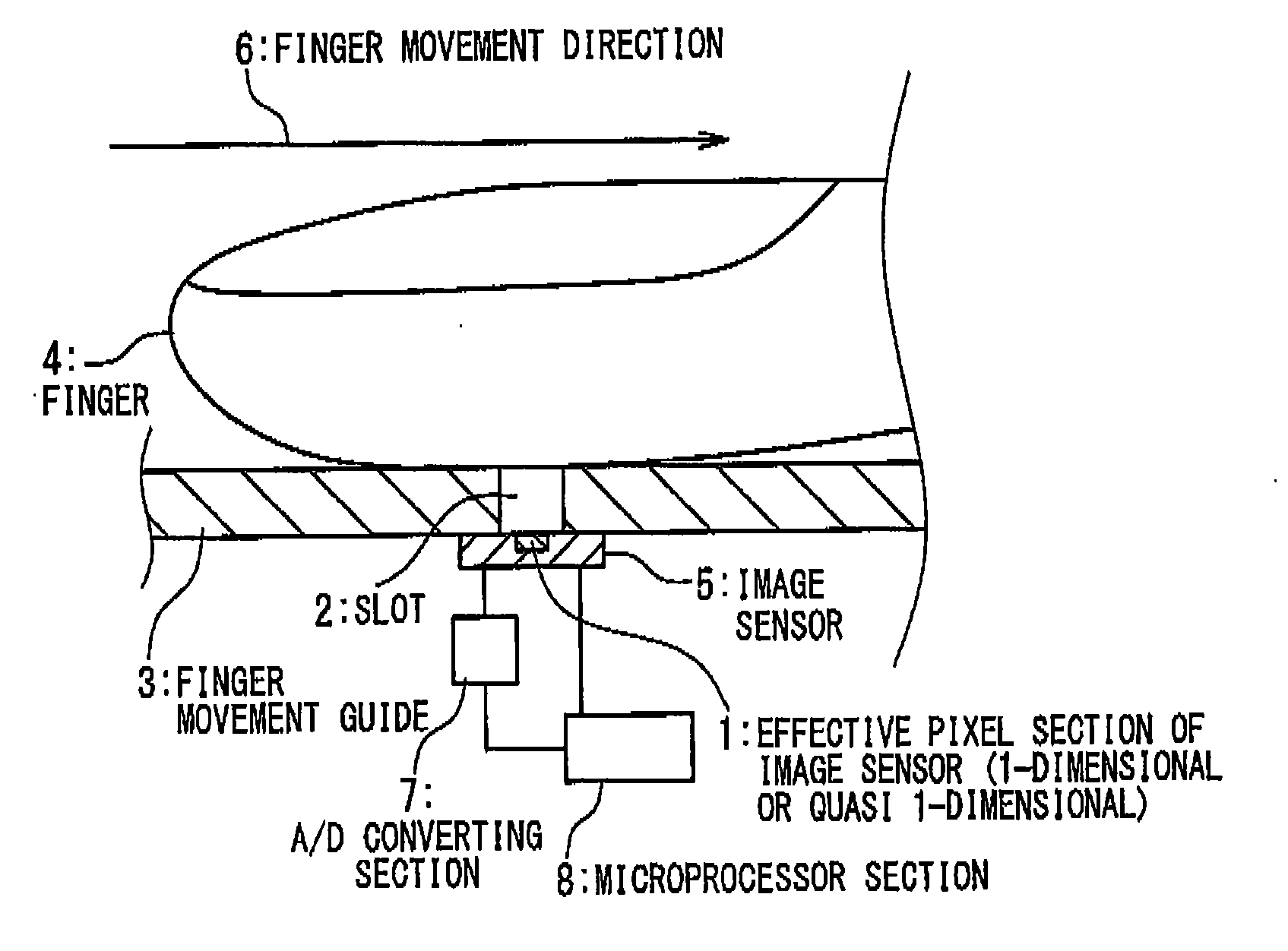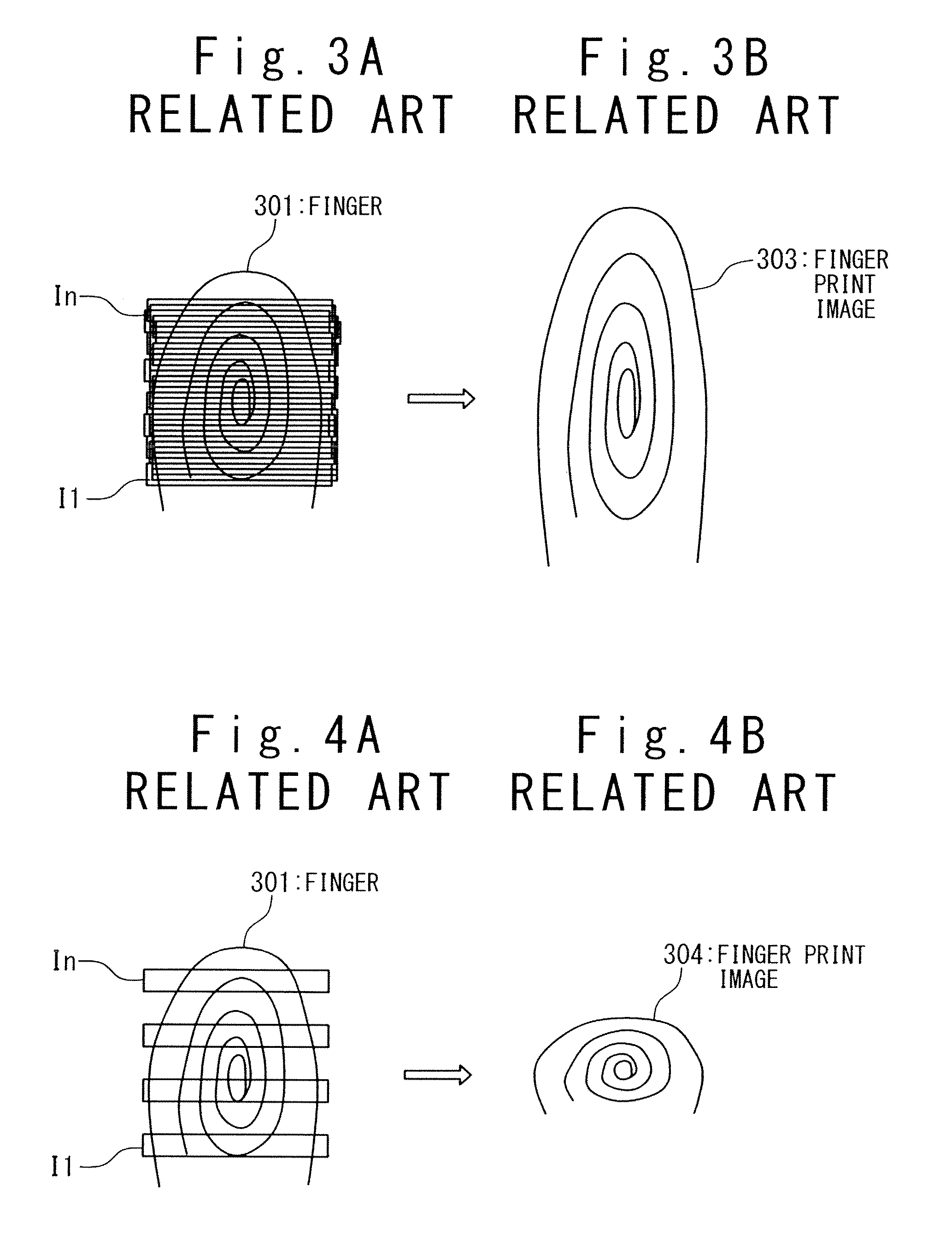Apparatus for inputting biometrical feature
a biometric and feature-based technology, applied in the field of biometrical feature-based inputting apparatus, can solve the problems of wide overlap between the partial images adjacent to each other, the distortion of the image, and the spoofing of personal information in the transaction on the network, so as to improve the precision of the image of the entire finger, prevent the image from being distorted, and image stably
- Summary
- Abstract
- Description
- Claims
- Application Information
AI Technical Summary
Benefits of technology
Problems solved by technology
Method used
Image
Examples
first embodiment
[0057]FIGS. 5A and 5B are views showing the biometrical feature inputting apparatus according to the first embodiment of the present invention. With reference to FIGS. 5A and 5B, the biometrical feature inputting apparatus according to the first embodiment includes a 1-dimensional or quasi 1-dimensional image sensor 5, a finger sliding guide 3 provided in such a manner that a gap 2 is located immediately above an effective pixel unit 1 on this image sensor 5, an A / D converter 7 for converting an analog output signal of the image sensor 5 into a digital signal, and a microprocessor 8 for controlling the imaging (operation) timing of the image sensor 5 and performing an imaging process on the digital signal outputted from the A / D converter 7.
[0058]The 1-dimensional image sensor 5 is an image sensor for one line, and the quasi 1-dimensional image sensor 5 is a rectangular image sensor of about 2 to 20 lines. When a ridge section interval in the fingerprint pattern is about 0.2 to 0.5 m...
second embodiment
[0067]With reference to FIGS. 10A and 10B, the biometrical feature inputting apparatus according to the second embodiment of the present invention differs from the first embodiment shown in FIGS. 5A and 5B, in that a light source of a plurality of light emitting devices is placed on the finger sliding guide 3, and the configurations other than it are same as those of the first embodiment.
[0068]The light emitting devices of the light source 151 are arranged in one line along the long side near the gap 2 of the finger sliding guide 3. When the finger 4 moving in the direction shown by the arrow 6 on the finger sliding guide 3 to image the fingerprint pattern, the finger 4 is illuminated from its finger cushion side (the side of the finger sliding guide 3), to generate the scattered light inside the finger. The reason why the light emitting devices are arrayed on the side on which the finger 4 is pulled with respect to the gap 2 as a center is to make it possible to sufficiently genera...
third embodiment
[0073]With reference to FIG. 14, the biometrical feature inputting apparatus according to the third embodiment of the present invention differs from the first embodiment shown in FIG. 1, in that a protection cover 801 made of optically transmissible solid is inserted into the gap 2 of the finger sliding guide 3, and the components other than it are same as those of the first embodiment.
[0074]The bottom plane of the protection cover 801 is in substantial contact with the effective pixel unit 1 of the image sensor 5, and its top plane is the substantially same plane as the top plane of the finger sliding guide 3. Thus, in order to read the fingerprint pattern of the finger 4, when the vicinity of the first knuckle of the finger 4 is put near the protection cover 801 embedded in the gap 2 of the finger sliding guide 3 and then the finger 4 is pulled so as to trace the protection cover 801, a part of the skin of the finger 4 is always in contact with the protection cover. Thus, among th...
PUM
 Login to View More
Login to View More Abstract
Description
Claims
Application Information
 Login to View More
Login to View More - R&D
- Intellectual Property
- Life Sciences
- Materials
- Tech Scout
- Unparalleled Data Quality
- Higher Quality Content
- 60% Fewer Hallucinations
Browse by: Latest US Patents, China's latest patents, Technical Efficacy Thesaurus, Application Domain, Technology Topic, Popular Technical Reports.
© 2025 PatSnap. All rights reserved.Legal|Privacy policy|Modern Slavery Act Transparency Statement|Sitemap|About US| Contact US: help@patsnap.com



